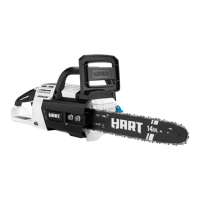2 – English
WARNING!
Read all safety warnings and all instructions.
Failure to follow the warnings and instructions
mayresultinelectricshock,fireand/orserious
injury.
Save all warnings and instructions for future
reference.Theterm“powertool”inthewarnings
referstoyourmains-operated(corded)powertool
orbattery-operated(cordless)powertool.
WORK AREA SAFETY
Keep work area clean and well lit. Cluttered
ordarkareasinviteaccidents.
Do not operate power tools in explosive
atmospheres, such as in the presence of
flammable liquids, gases or dust. Power
toolscreatesparkswhichmayignitethedust
or fumes.
Keep children and bystanders away while
operating a power tool. Distractions can
cause you to lose control.
ELECTRICAL SAFETY
Power tool plugs must match the outlet.
Never modify the plug in any way. Do not use
any adapter plugs with earthed (grounded)
power tools. Unmodifiedplugsandmatching
outlets will reduce risk of electric shock.
Avoid body contact with earthed or ground-
ed surfaces such as pipes, radiators, ranges
and refrigerators. There is an increased risk
of electric shock if your body is earthed or
grounded.
Do not expose power tools to rain or wet
conditions. Waterenteringa powertool will
increase the risk of electric shock.
Do not abuse the cord. Never use the cord
for carrying, pulling or unplugging the power
tool. Keep cord away from heat, oil, sharp
edges or moving parts. Damaged or entangled
cords increase the risk of electric shock.
When operating a power tool outdoors, use
an extension cord suitable for outdoor use.
Use of a cord suitable for outdoor use reduces
the risk of electric shock.
If operating a power tool in a damp location
is unavoidable, use a ground fault circuit
interrupter (GFCI) protected supply. Use of
a GFCI reduces the risk of electric shock.
PERSONAL SAFETY
Stay alert, watch what you are doing and
use common sense when operating a power
tool. Do not use a power tool while you are
tired or under the influence of drugs, alcohol
or medication.Amomentofinattentionwhile
operatingpower toolsmay resultin serious
personalinjury.
Use personal protective equipment. Always
wear eye protection.Protective equipment
such as dust mask, non-skid safety shoes, hard
hat,orhearingprotectionusedforappropriate
conditionswillreducepersonalinjuries.
Prevent unintentional starting. Ensure the
switch is in the off-position before connect-
ing to power source and/or battery pack,
picking up or carrying the tool. Carrying
powertoolswithyourfingerontheswitchor
energisingpowertoolsthathavetheswitchon
invitesaccidents.
Remove any adjusting key or wrench before
turning the power tool on. Awrenchorakey
leftattachedtoarotatingpartofthepowertool
mayresultinpersonalinjury.
Do not overreach. Keep proper footing and
balance at all times. This enables better con-
trolofthepowertoolinunexpectedsituations.
Dress properly. Do not wear loose cloth-
ing or jewellery. Keep your hair, clothing
and gloves away from moving parts. Loose
clothes, jewellery or long hair can be caught in
movingparts.
If devices are provided for the connection of
dust extraction and collection facilities, en-
sure these are connected and properly used.
Use of dust collection can reduce dust-related
hazards.
POWER TOOL USE AND CARE
Do not force the power tool. Use the correct
power tool for your application. The correct
powertoolwilldothejobbetterandsaferat
the rate for which it was designed.
GENERAL POWER TOOL SAFETY RULES

